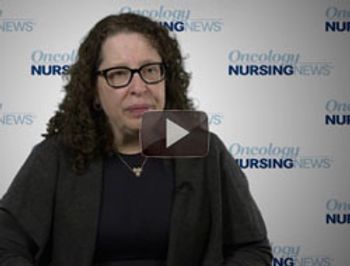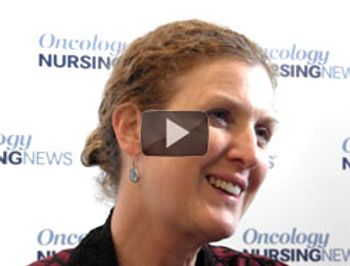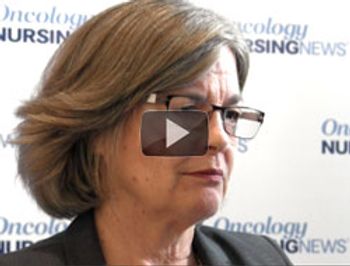
Men newly diagnosed with breast cancer need a great deal of support, in part because of how rare breast cancer is in men, and because the typical reaction to a breast cancer diagnosis is one of disbelief.

Men newly diagnosed with breast cancer need a great deal of support, in part because of how rare breast cancer is in men, and because the typical reaction to a breast cancer diagnosis is one of disbelief.

Maybe in these most profound moments after a diagnosis of breast cancer, we are called to be still.

Drawing a standing ovation from a packed room of oncology professionals attending the 33rd Annual Miami Breast Cancer Conference®, breast cancer survivor and Good Morning America news anchor Amy Robach criticized new US Preventive Services Task Force guidelines that extend the recommended age to begin mammogram screening to age 50 for women at average risk.

Bright Pink's Women's Health Provider Education program is designed to address gaps in knowledge of young women's genetic cancer risk.

The first study to assess smoking habits of women with breast cancer before and after diagnosis has found that those who quit smoking after their diagnosis had a 33% lower risk of dying of the disease than those who continued to smoke.

Women under 40 who find a suspicious lump in their breast often have their cancer fears dismissed and are told “you are too young for breast cancer,” according to Megan McCann, associate director of programs at the Young Survival Coalition. Here, she discusses breaking down that misconception that younger women can’t get breast cancer.

The benefits of 3D mammography are durable, increasing detection of breast cancers and reducing anxiety over callbacks, according to a recent study that provides the first longitudinal evidence of the utility of this approach.

Patients with pretreated, HR-positive, HER2-negative metastatic breast cancer can now receive palbociclib (Ibrance) for use in combination with fulvestrant following the FDA’s recent approval of this new indication for the CDK 4/6 inhibitor.

A study involving nearly 30,000 patients diagnosed with early-stage breast cancer has found that up to 60% of these women received imaging tests such as CT, bone, and PET scans that were not medically justified, contrary to national guidelines.

After being diagnosed with breast cancer, Susan Rafte and her sister started The Pink Ribbons Project is a Houston-based nonprofit that provides surrounding communities with access to fundamental breast health services via awareness programs, fundraising events and community collaboration.

Freya R. Schnabel, MD, discusses the importance of choosing individualized treatment options for patients with breast cancer.

Holly Pederson, MD, discusses the unique contributions of nurses on her team.

The American Cancer Society and American Society of Clinical Oncology collaborated to create survivorship guidelines to assist primary care and other clinicians in the care of women with breast cancer.

Breast reconstruction surgery has become an increasingly popular option among women following mastectomy, but a recent study has found that most women who opt for the procedure are ill-informed of the potential risks.

Using an individualized approach to decide whether asymptomatic women under age 50 should have mammograms is at the center of the final screening guidelines published by the US Preventive Services Task Force (USPSTF), but the group

New research has found that low-income breast cancer survivors are more likely to adhere to recommended survivorship care if they receive counseling along with a treatment summary and survivorship care plan (TSSP).

Lisa Carey, MD, professor of medicine, University of North Carolina at Chapel Hill, discusses the need to minimize interventions for breast cancer treatment.

Marie Wood, MD, medical oncologist, University of Vermont, discusses the correlation between aspirin use and lower breast density.

Hope S. Rugo, MD, director of Breast Oncology and Clinical Trials Education, UCSF Helen Diller Family Comprehensive Cancer Center, discusses the DigniCap cooling system to reduce the severity and frequency of hair loss in patients receiving chemotherapy for breast cancer.

Women with early-stage breast cancer who were treated with breast-conserving therapy (BCT) and radiation had improved survival after 10 years compared with those who had a mastectomy without radiation, according to research findings presented recently at the 2015 SABCS.

Practitioners awaiting guidelines for the optimum support of breast cancer survivors now have a resource to turn to with the release of a new clinical oncology breast cancer survivorship care guideline, a collaborative effort of ASCO and ACS.

A recent study has found that the majority of women at an increased risk of developing breast cancer either refuse or do not adhere to preventive treatment.

For women with heavily treated HER2-positive breast cancer, T-DM1 (ado-trastuzumab emtansine, Kadcyla) was found to improve overall survival (OS) by 7 months according to updated data from a phase III trial.

The immunotherapy pembrolizumab (Keytruda) demonstrated on overall response rate (ORR) of 12% in patients with ER-positive, HER2-negative advanced breast cancer in the phase 1b KEYNOTE-028 trial, marking the second early-stage trial to show antitumor activity with this agent in breast cancer.

A new study has shown that overall quality of life is similar among patients taking tamoxifen or anastrozole, but patient reports on their hot flashes, night sweats, vaginal dryness, and joint pain can help illuminate which therapy may be right for a particular woman. And, the analysis shows, age matters.